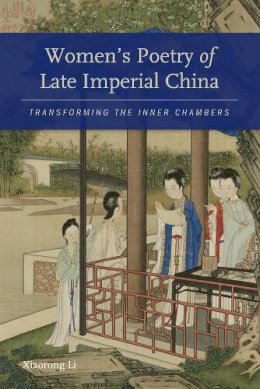
Women's Poetry of Late Imperial China
Xiaorong Li
This study of poetry by women in late imperial China examines the metamorphosis of the trope of the "inner chambers" (gui), to which women were confined in traditional Chinese households, and which in literature were both a real and an imaginary place. Originally popularized in sixth-century "palace style" poetry, the inner chambers were used by male writers as a setting in which to celebrate female beauty, to lament the loneliness of abandoned women, and by extension, to serve as a political allegory for the exile of loyal and upright male ministers spurned by the imperial court. Female writers of lyric poetry (ci) soon adopted the theme, beginning its transition from male fantasy to multidimensional representation of women and their place in society, and eventually its manifestation in other poetic genres as well.
Emerging from the role of sexual objects within poetry, late imperial women were agents of literary change in their expansion and complication of the boudoir theme. While some take ownership and de-eroticizing its imagery for their own purposes, adding voices of children and older women, and filling the inner chambers with purposeful activity such as conversation, teaching, religious ritual, music, sewing, childcare, and chess-playing, some simply want to escape from their confinement and protest gender restrictions imposed on women. Women's Poetry of Late Imperial China traces this evolution across centuries, providing and analyzing examples of poetic themes, motifs, and imagery associated with the inner chambers, and demonstrating the complication and nuancing of the gui theme by increasingly aware and sophisticated women writers.
Product Details
About Xiaorong Li
Reviews for Women's Poetry of Late Imperial China
Wai-yee Li
Harvard Journal of Asiatic Studies
"Xiaorong Li’s book opens up this lost world for readers. . . . This book offers an insightful peep into the inner chambers of late-imperial China. It is just as suitable for general readers as it is for those who have foundational knowledge of Chinese history and literature. . . . [A]n enjoyable introduction to Chinese women’s history."
Queenie Kwan Yee Lo
New England Journal of History
"[A]n illuminating study of Chinese women’s poetry from the late Ming to the early Republic, focusing on the trope of the gui (“boudoir” or “inner quarters”). . . . In giving sensitive translations and insightful commentaries on this “boudoir” poetr, Xiaorong Li has demonstrated its relevance far beyond the inner quarters in documenting three centuries of women’s participation in social, political and cultural change."
Paul S. Ropp
The China Quarterly
"The book successfully shows the manifold significance of the poetics of the gui, which fills a gap in Western scholarship on women poets in late imperial China. . . . A valuable addition to the field of gender studies and the field of traditional Chinese poetry and poetics."
Ji Hao
Ming Studies
